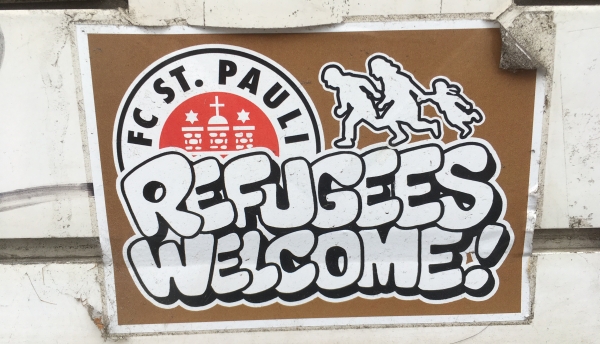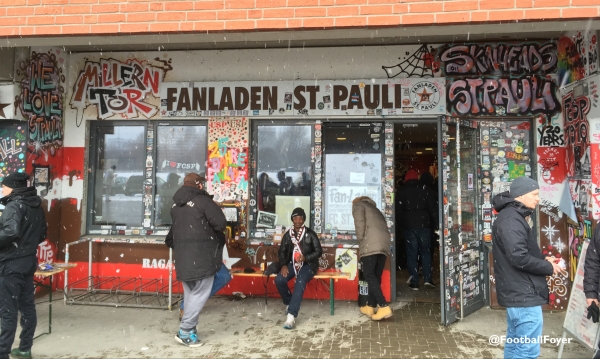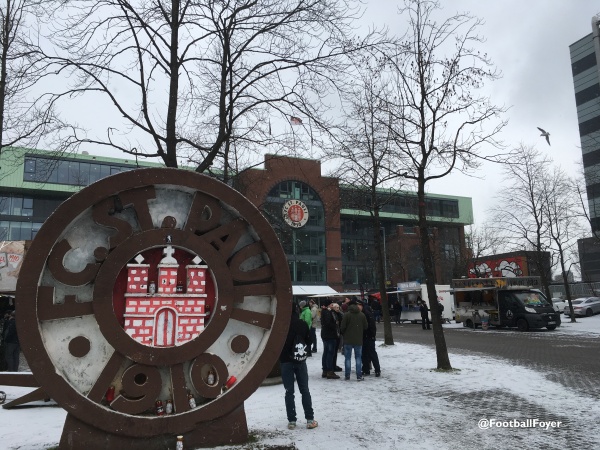By Danny Wyn Griffith
Welcome all refugees. Fuck the Nazis. Anti-homophobia flags aplenty. Less caring for the match result, more about the enjoyment that accompanies the occasion. Welcome to match day at FC. St Pauli’s Millerntor-Stadion.
Upon approaching the stadium, graphically trippy images greet you along with the bolded Millerntor-Stadion print. With a polar vortex swallowing most of Europe, snow also surrounds the iconic stadium – increasing the mystical feel.

The Millerntor-Stadion, within a stone’s throw of the docks and renowned Reeperbahn red-light district, houses football’s most ardent left-wing followers.
Three decades ago, a following from St. Pauli’s squatting community were first seen behind the manager’s dugout. There they would chant against fascism and racism. From then on FC St. Pauli’s following became renowned for being punks, embodying left-wing beliefs, stating everyone would be welcomed at the Millerntor.
They adopted the skull and crossbones flag, which remains famously adorned across the club’s world-famous commercial juggernaut to this very day. With this came new supporters, who rejected the neo-Nazi vibes elsewhere in football during that period.
Over the years, the fans have also proven to be their beloved club’s saviours. When facing financial difficulties, they staged fundraising initiatives such as Drink for St. Pauli, where local landlords would donate 50 percent from each beer sold. Here, the club and fans are one – a close-knit community, the perfect hand to fit the glove.

On the cards this particular day was a local derby against Holsten Kiel, a team situated the mere 30km from St. Pauli. I arrived early, a good two hours prior to kick-off. Yet this doesn’t explain the obstacles encountered that very morning.
Catching an early 7am train from Berlin towards Hamburg, all seemed to be going rosily, and as with such occasions – complacency kicked in and a slight bump occurred in my journey. Twenty-seven miles east of Hamburg, a minor accident happened further along the line. My train stopped, everyone was heading out – the train was going no further.
Hoping to step out into civilisation, I soon realised I wasn’t so lucky. Having got on the train in 2018, it felt like we got off in 1978. The place, called Büchen, seemingly had no businesses open. Taxis, with none in sight, felt like a made-up concept. The next train wasn’t due for a few hours and people seemed few and far between.

I spot a little garage around 500 yards from the train station and head towards it. Upon entering, I spot a fellow stranded passenger. I introduce myself, explain the predicament, and to my content he explains he has a taxi booked which I could jump in on, heading towards a little town called Bergedorf. From there I’d be able to take the U-Bahn towards Hamburg. I gladly accept.
The saviour, an ukulele teacher, had a lesson to reach. Upon arriving Bergedorf, the taxi meter reached €80 – split between four, it didn’t seem too bad when accounting for the fact I was in real danger of missing the match.
Out at Bergedorf, into the U-Bahn station. I soon realised the misjudgement. The same German error message as seen at Büchen was showing up against the U-Bahn towards Hamburg. Whatever the incident, it was also affecting this line. Once again threatened by the possibility of missing the match, I call on yet another taxi.
Finally, this journey goes to plan and, in doing so, means I’m dropped in St. Pauli itself, with the Millerntor-Stadion’s rough edges in sight. Having arranged my ticket via FC St. Pauli’s Fanladen initiative, I head straight towards their base.

Founded 25 years ago, Fanladen St. Pauli is situated at the Heiligengeistfeld, not far from the middle of Gegengerade-Stand of the Millerntor-Stadium. The Fanladen is responsible for taking care of the fan scene and is the go-to meeting points for St. Pauli fans from across the globe.
They offer special assistance to local and international supporters who want to visit the famous Millerntor-Stadion. With a growing list of more than 200 fan-clubs worldwide, the demand for tickets is increasing.
But what makes this work so smoothly, is the fact they’re independent of the club, which means the Fanladen can represent fans without being under pressure of commercial or political needs.

Despite being independent, the representatives and employees of the Fanladen are also members of different club committees in order to take care of fans’ interests. This close cooperation of the independent Fanladen and the club is one of the key structures making FC St. Pauli different from other clubs.
Upon entering their base, you sense the uniqueness. Inside, there’s a small soup kitchen to provide for the homeless. Tables are covered by stickers ranging from different fan clubs, to ones advocating the legalisation of marijuana and a call to arms in the fight against racism.
I receive my ticket, €13.50, and head out to witness the stadium and its surrounding area at close quarters.

A huge stone club emblem stands like a shrine amidst currywurst, USP (ultra group) and Greenpeace stalls. I walk towards the famous Jolly Roger, a punk pub known for celebrating results – whether win, draw or lose – deep into the night. But upon entry I realise the bar is packed to the rafters, therefore I headed back out in search of another establishment to cure my thirst.
I find one just around the corner. A sign faces me upon entering, stating: “No racism, no sexism, no homophobia, no antisemitism; no discussion.”
With the thirst cured, I made my way to the match. Another misjudgement occurred when I walked up a set of packed stairs, only to realise my ticket was at the other end of the ground. Having squeezed my way back down, I found my turnstile at the Nordtribüne end.
Out into the stand, I’m faced by the famous Südkurve. Renowned for their pyro demonstrations, I eagerly awaited what they had up their sleeves.
With the players making their way onto the pitch, the Südkurve kicked into action. Rastafarian colours emerge, accompanied by ‘stay rude, stay rebel’, split in two by the club’s emblem and edged by the revolutionary Cuban leader Che Guevara and a cannabis leaf.
As the match kicks off, I soon realise FC St. Pauli face a tough contest. Holsten Kiel pinged the ball around with confidence, demonstrating why they were placed six places higher up the table compared to their opponents.
Yet, against the early run of play, FC St. Pauli break, get the ball forward and it falls to left-midfielder Richard Neudecker, who finished with aplomb.
Here I realise Blur’s Song 2 is played after each home goal in celebration – whilst prior to the match AC/DC’s Hell’s Bells was also roared through the Millerntor-Stadion’s speakers. Nevertheless, the St. Pauli faithful had another thing coming if they believed this was the start of a positive victory.
Soon after taking the lead, the match turned on its head. In a quick five-minute overhaul, Holsten Kiel went from 1-0 down to 2-1 up, thanks to quick-fire goals by Kingsley Schindler and Marvin Ducksch.
The rapid Holsten Kiel comeback didn’t face the Millerntor-Stadion faithful. Sure, the goals fired up the visiting fans, who were finely orchestrated by three vocal front-men, still the home fans refused to be disheartened and seemed intent on pushing ahead with the festival-like atmosphere.
As half-time approached, a large heart shaped flag was unfurled to the back of our stand. Simple in design, but effective in message. Being an FC St. Pauli follower is all about the love, and certainly no hatred.

The visitors’ swift second-half start threatened to turn the match into a Holsten Kiel rout. FC St. Pauli, however, dug deep, holding their own and, in due course, brought about their just reward.
With a quarter of an hour left to play, the home side nicked an equaliser. The ball was flicked over the right-sided Kiel defender, onto the arriving left-footed half volley of Richard Neudecker. The ball rocketed into the net, hit so sweetly that ripples were felt 30km down the road in Kiel. St. Pauli were level. From this point on, you felt there could only be one winner.
As added time approached, FC St. Pauli were awarded a corner. An inswinging near-post ball is met by the head of Christopher Avevor – who had excelled throughout the match – and beats Holsten Kiel goalkeeper, Kenneth Kronholm.
The Millerntor-Stadion erupts as their side completed an emphatic turnaround. Their rivals were dead on their feet.

St. Pauli closed out the match. The party atmosphere increased in volume. No hard feelings were seen between both sets of fans – with all seemingly more than content at the footballing feast they’d been a part of.
To my regret, I had to catch a ride back to Berlin, therefore headed from the stadium just after full-time. Although I’m reliably told the St. Pauli faithful saw out the next few hours singing, dancing and celebrating, with David Bowie’s ‘Let’s Dance’ and €3 Riesling a popular favourite at a wine bar adjoined to the stadium.
The Millerntor-Stadion offers a truly alternative footballing experience, with FC St. Pauli and their fans spearheading aims to bring peace to the game, whilst also being a competitive 2. Bundesliga side – and hopefully, a Bundesliga side once more in the near future.
As one fan, who was on his second visit to the Millerntor-Stadion, finely put it: “Everyone needs a home and I’ve found mine.”

You must be logged in to post a comment.